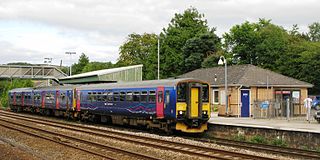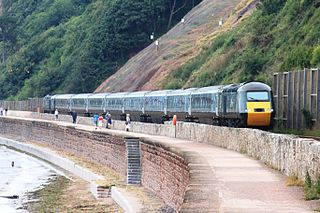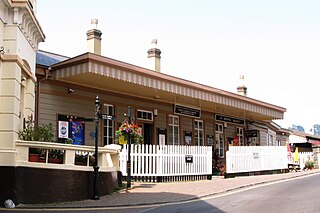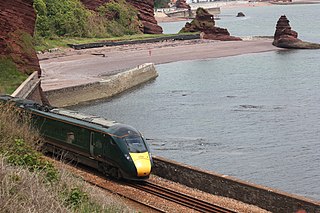
Newton Abbot is a market town and civil parish on the River Teign in the Teignbridge District of Devon, England. Its 2011 population of 24,029 was estimated to reach 26,655 in 2019. It grew rapidly in the Victorian era as the home of the South Devon Railway locomotive works. This later became a major steam engine shed, retained to service British Railways diesel locomotives until 1981. It now houses the Brunel industrial estate. The town has a race course nearby, the most westerly in England, and a country park, Decoy. It is twinned with Besigheim in Germany and Ay in France.

An atmospheric railway uses differential air pressure to provide power for propulsion of a railway vehicle. A static power source can transmit motive power to the vehicle in this way, avoiding the necessity of carrying mobile power generating equipment. The air pressure, or partial vacuum can be conveyed to the vehicle in a continuous pipe, where the vehicle carries a piston running in the tube. Some form of re-sealable slot is required to enable the piston to be attached to the vehicle. Alternatively the entire vehicle may act as the piston in a large tube or be coupled electromagnetically to the piston.

The Riviera Line is the railway between the city of Exeter, towns Dawlish and Teignmouth, and the English Riviera resorts of Torbay in Devon, England. Its tracks are shared with the Exeter to Plymouth Line along the South Devon sea wall. It is part of the Network Rail Route 12.

Exeter St Davids is the principal railway station serving the city of Exeter in Devon, England. It is 193 miles 72 chains from the zero point at London Paddington on the line through Bristol which continues to Plymouth and Penzance. It is also served by an alternative route to London Waterloo via Salisbury and branch lines to Exmouth, Barnstaple, and Okehampton. It is currently managed by Great Western Railway and is served by trains operated by Great Western Railway, South Western Railway and CrossCountry.

Exeter St Thomas railway station is a suburban railway station in Exeter, England, serving the suburb of St Thomas and the riverside area. The station is elevated on a low viaduct with entrances on Cowick Street. It is 74 chains down the line from Exeter St Davids and 194 miles 66 chains measured from the zero point at London Paddington via Box Tunnel.

Starcross railway station is a small station on the Exeter to Plymouth line in the village of Starcross, Devon, England. It is 8 miles 44 chains (13.8 km) down the line from Exeter St Davids and 202 miles 36 chains (325.8 km) measured from London Paddington via Box. The station is managed by Great Western Railway, who operate all trains serving it.

Teignmouth railway station is on the Exeter to Plymouth line and serves the seaside town of Teignmouth in Devon, England. It is located 208 miles 70 chains (336 km) from London Paddington, via Box. It is operated by Great Western Railway and is the third-busiest station on the Riviera Line after Exeter St Davids and Newton Abbot.

Newton Abbot railway station serves the market town of Newton Abbot in Devon, England. It is 214 miles 5 chains (345 km) from London Paddington. The station today is managed by Great Western Railway, who provide train services along with CrossCountry.

Totnes railway station serves the towns of Totnes and Dartington in Devon, England. It was opened by the South Devon Railway Company in 1847. Situated on the Exeter to Plymouth Line, it is 222 miles 66 chains measured from the zero point at London Paddington via Box.

Torquay railway station is on the Riviera Line and serves the seaside resort of Torquay, Devon, England. It is 219 miles 79 chains (354 km) from London Paddington.

Torre railway station is a suburban station on the Riviera Line in Torquay, Devon, England. It is 219 miles 12 chains (353 km) measured from London Paddington. The station is managed by Great Western Railway but is not staffed.

Isambard Kingdom Brunel was a British civil engineer and mechanical engineer, who is considered "one of the most ingenious and prolific figures in engineering history", "one of the 19th-century engineering giants", and "one of the greatest figures of the Industrial Revolution, [who] changed the face of the English landscape with his groundbreaking designs and ingenious constructions". Brunel built dockyards, the Great Western Railway (GWR), a series of steamships including the first purpose-built transatlantic steamship, and numerous important bridges and tunnels. His designs revolutionised public transport and modern engineering.

The South Devon Railway sea wall is situated on the south coast of Devon in England. A footpath runs alongside the railway between Dawlish Warren and Dawlish, then another footpath forms a continuation to the sea front promenade at Teignmouth. Both of these form part of the South West Coast Path.
The Buckfastleigh, Totnes and South Devon Railway built the broad gauge railway line from Totnes to Buckfastleigh and Ashburton in Devon, England.

The Dartmouth and Torbay Railway was a broad gauge railway linking the South Devon Railway branch at Torquay with Kingswear in Devon, England. It was operated from the outset by the South Devon Railway.
The South Devon Railway Company built and operated the railway from Exeter to Plymouth and Torquay in Devon, England. It was a 7 ft 1⁄4 in broad gauge railway built by Isambard Kingdom Brunel.

George Hennet (1799–1857) was an English railway engineer and contractor. He undertook many contracts for Isambard Kingdom Brunel's broad gauge railways in the South West of England and funded the provision of extra facilities on the South Devon Railway, these formed the basis of a general trading business that he conducted.
The South Devon Banks are a series of steep inclines on the ex-GWR railway line linking Exeter and Plymouth in Devon, England. These two cities are separated by the rocky uplands of Dartmoor forcing the early railway surveyors to propose that the line skirt the difficult terrain of the comparatively sparsely populated moorland. Isambard Kingdom Brunel, in surveying the South Devon Railway, opted to push a line along a coastal strip between the Exe and Teign valleys, and then to climb the southern outliers of Dartmoor making for the head of the Plym estuary. From Newton Abbot, the line climbs Dainton Bank, and from Totnes it climbs Rattery Bank, reaches a peak at Wrangaton summit, and then descends Hemerdon Bank to reach Plymouth. These three are collectively known as the South Devon Banks.

The Exeter–Plymouth line, also called the South Devon Main Line, is a central part of the trunk railway line between London Paddington and Penzance in the southern United Kingdom. It is a major branch of the Great Western Main Line and runs from Exeter St Davids to Plymouth, from where it continues as the Cornish Main Line. It was one of the principal routes of the Great Western Railway which in 1948 became part of the Western Region of British Railways and are now part of the Network Rail system.




















